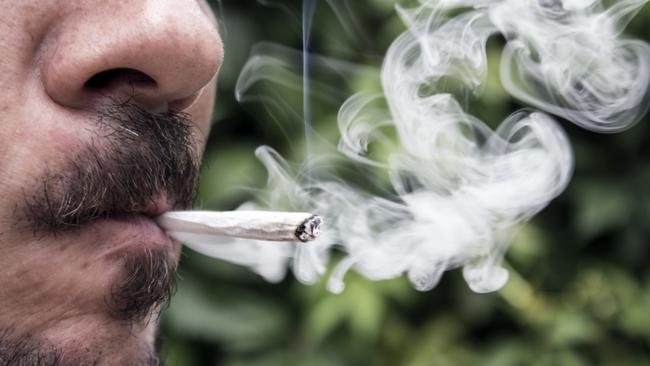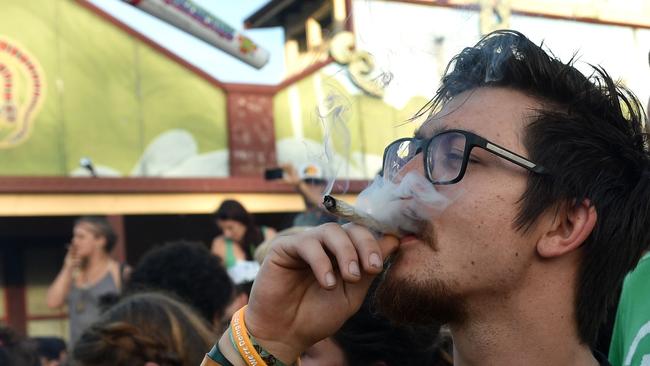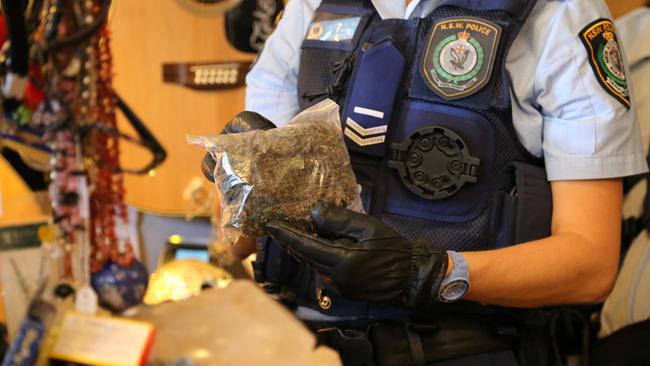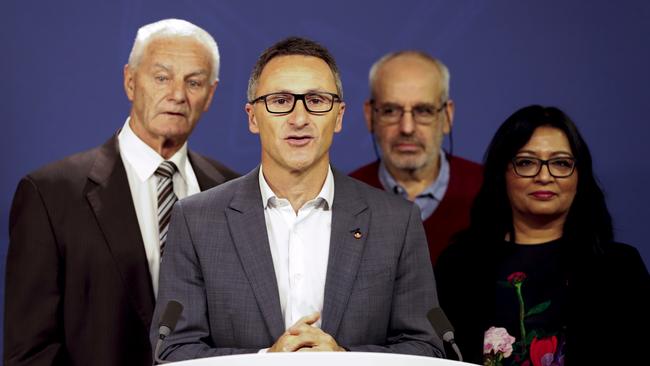The dope on legal marijuana
A campaign for the legalisation of marijuana faces many hurdles.

Health regulators have sought to make a clear distinction between medicinal cannabis and recreational marijuana. A line is drawn between those who could obtain health benefits from the part of the plant understood to relieve symptoms of medically diagnosed conditions, and those who simply smoke weed for pleasure — despite the often-repeated health risks. In Australia, this line is determined by medical evidence and criminal law.
At one extreme, there are children managing their epilepsy, while at the other extreme there are adults battling self-inflicted, drug-induced psychosis.
This is a distinction Greens leader Richard Di Natale, a former doctor, also had sought to make and defend in recent years as he pushed for the seriously ill to have greater access to medicinal cannabis. At least, that was the case until last week, when Di Natale launched the Greens’ campaign for the legalisation of marijuana, blurring the lines completely.
Buoyed by the apparent success of the medicinal cannabis campaign, the Greens have moved from advocating the decriminalisation of marijuana — something Di Natale personally has pushed for more than a decade — to outright legalisation for adult use. The intent is essentially to freeze criminals out of the market, guarantee a safer supply of drugs and, in theory, promote treatment instead of prosecution.
GRAPHIC: The legal status of cannabis
In doing so, Di Natale has taken the Greens from sharing unlikely political consensus on medicinal cannabis (support extended right to One Nation) to once again being isolated on complex policy matters. The underdeveloped legalisation plan already has failed to gain support from larger political parties or the major health groups, and may have undermined ongoing efforts to improve access to medicinal cannabis.
Not long after he became leader in 2015, Di Natale addressed the MardiGrass Hemposium at Nimbin, NSW, the marijuana capital of Australia — “I’ve been to Nimbin a few times, it’s always fun being here” — and repeated his concerns over drug policies.
Di Natale told the assembled crowd of his work in a cross-parliamentary group pushing for medicinal cannabis. While he sought to focus on the potential health benefits for those with a clinical need, within a regulatory system, audience members repeatedly suggested the plant had much broader benefits, starting with cheap and simple stress relief (some still wrongly claim it cures cancer).

On a stage adorned with the banner “We Are Not Criminals”, Di Natale acknowledged another speaker’s account of drug law reform in the US, where some states allowed for medicinal cannabis and, later, recreational cannabis. To all in the room, the endgame was legalisation, as if one reform followed the other.
“In America, the experience was (with) medicinal cannabis, people got to see that as an effective treatment, they got to see that in terms of side effects, some of the concerns that they had were allayed and the result was that the issue of recreational cannabis was able to be discussed in a different context,” Di Natale said.
“My focus is purely on the medicinal cannabis debate at the moment … (and) I don’t want to do anything that’s going to jeopardise that. If we can get that over the line, then people can have a discussion about recreational use and what that might look like, what a regulated market might look like, but I want to keep those two debates very separate.”
Last week, those debates converged. Only days after the Council of Australian Governments Health Council on Friday decided to refine further the laws applying to medical cannabis, Di Natale launched his overarching legalisation campaign. His media blitz was supported by fellow long-time law reform advocates Alex Wodak, a physician and president of the Australian Drug Law Reform Foundation, and retired federal police commissioner Mick Palmer, and was applauded on various online drug forums.
“The war on drugs is really a war on people,” Di Natale told the Ten Network’s The Project. “As someone who was a drug and alcohol doctor, I’ve seen how damaging the tough-on-drugs approach is to people. We’ve got to take this out of the hands of criminals and dealers, we’ve got to make sure it is within the hands of health professionals.”
Yet the groups representing health professionals were not convinced. Royal Australian College of General Practitioners president Bastian Seidel warned the risks of cannabis use were being lost in the debate over medicinal cannabis.
“It’s really difficult for the public to understand the difference between medicinal cannabis and recreational cannabis,” Seidel said.
“It’s unfortunate timing that we are talking about medicinal cannabis right now and now a new debate about recreational cannabis is being thrown in.”
Australian Medical Association president Michael Gannon would have backed a push for further decriminalisation amid increased prevention efforts. But he said “legalisation of recreational cannabis would be a mental health disaster”.
Seidel pointed to a report last year from the National Academies in the US that sought to assess the evidence for and against cannabis at what it called “a pivotal time in the world of cannabis policy and research”.
While calling for more research on possible therapeutic benefits and greater surveillance of possible harms, the National Academies maintained there was “substantial evidence” of a link between cannabis smoking and schizophrenia or other psychoses, car crashes, respiratory problems, underweight babies and other health problems.
Previously, in opposing government cuts to drug and alcohol treatment services, Di Natale argued that drug addiction must be treated as a health issue, not a criminal issue.
“We don’t arrest people who develop diabetes but here we have people struggling with a serious health issue where we actively intervene (through law enforcement) to minimise any chance they have of recovery,” he told parliament in 2015.

The Australian Institute of Health and Welfare last week reported that the number of alcohol and drug treatment services delivered each year had increased by 30 per cent across the past decade. The most common principal drug of concern was alcohol (32 per cent of all treatment episodes in 2016-17), followed by amphetamines (26 per cent) and cannabis (22 per cent).
Yet the proportion of Australians using cannabis appears steady. A 2013 government survey found 34.8 per cent of Australians aged 14 and older had used cannabis at least once (down from 35.4 per cent in 2010) and 10.2 per cent were recent users (10.3 per cent in 2010).
A 2015 study of regular injecting drug users found 73 per cent had recently used cannabis, often referred to as a “gateway drug” to more serious substances, and the latest results appear similar.
Last year, researchers Peter Homel and Rick Brown from the Australian Institute of Criminology took a closer look at the US experience, both with medicinal cannabis and recreational cannabis. They referred to three movements of marijuana drug reform during the past 25 years: de facto decriminalisation in the 1980s after the “explosion of drug use” in the 60s and 70s, followed by the medicinal cannabis push in the 90s that now has been adopted by more than 30 states in varying forms.
“The third major legislative reform movement has been the push to legalise recreational marijuana use and its commercial sale to adults,” they wrote, noting, at that stage, eight states that had gone down the path of legalisation.
Homel and Brown argued it was still too early to assess the impact of allowing recreational cannabis use in the US. Research on whether it increased drug-taking differed, and the criminal and economic impacts — often used to justify legalisation — were distorted by the nature of the reform and how it varied by jurisdiction.
In passing, they noted some studies suggested young people were likelier to use marijuana for recreational purposes if they had been exposed to information about its medicinal uses.
The researchers also highlighted the unresolved conflicts with other laws and other jurisdictions, and the risk of cannabis being diverted for illicit purposes. That also would be an issue in Australia.
For example, most states have drug-driving laws, where motorists are tested for illicit substances known to impair driving, including marijuana. Some states have drug diversion programs, and some have even tried to ban cigarette smoking in prison, with policy consistency already an issue.
Federally, the most recent policy change on drugs has been to test welfare recipients for marijuana and other drugs, out of concern they might be spending the public dime on illicit substances.
Under the Greens’ plan, it is not clear whether recreational users would, or could, be excused from these laws and programs.
The latest statistics from the Australian Criminal Intelligence Commission show 2015-16 was a bumper year for the war on marijuana — more arrests than ever (79,643), more seizures than ever (61,334), and more detections at the border (7504), although domestic production still dominates.

Six months ago, in a Senate committee hearing in Canberra, Di Natale fired up at the Therapeutic Goods Administration’s John Skerritt, who has the unenviable job of trying to facilitate access to medicinal cannabis within Australia’s strong regulatory framework.
The pace at which governments have responded to community calls for medicinal cannabis is unheralded, and in stark contrast to efforts to restrict access to codeine and subsidies for unproven natural therapies.
Di Natale had never wanted Skerritt’s agency involved. In 2014, Di Natale said “the TGA is just not geared up for a natural substance like cannabis” and a new agency should be established, similar to the Australian Cannabis Agency he is now advocating for the recreational market.
To Skerritt, glowing personal accounts of the benefits of medicinal cannabis meant nothing without scientific evidence of its efficacy and safety, preferred composition, and strict controls to determine who could provide, prescribe and use the drug.
Although technical, there is a difference between tetrahydrocannabinol, the strain responsible for its psychoactive effects, and cannabinoid, which has shown the most promise as a therapy.
But in the hearing, Di Natale was incensed at all the bureaucratic rules and paperwork required. (In a previous hearing, he took offence to Skerritt’s suggestion that without proper controls people might start “turning up at an airport with a suitcase of cannabis”).
The Victorian senator was growing impatient.
“Do you think it’s strange that we’ve got, say, 10,000 doctors and they can all prescribe codeine, opiates — drugs that people can overdose on and where people are occasionally diverted to the illicit market and they are fatal in overdose — and yet we only have 100 or so doctors that can prescribe medicinal cannabis?” Di Natale asked.
Skerritt rejected the assertion that only 100 doctors could prescribe medicinal cannabis, suggesting more could but perhaps were showing caution.
“We had had literally, probably, dozens of meetings with GPs about medicinal cannabis and with specialist organisations this year,” Skerritt told Di Natale.
“The overwhelming majority are hesitant to prescribe because they have some degree of view that the evidence is not substantial enough.”
The government has released guides for doctors who might be asked about the potential use of medicinal cases of palliative care, multiple sclerosis, chemotherapy-induced nausea and vomiting, chronic non-cancer pain and epilepsy, for which there is the most evidence.
Di Natale was confident the evidence was on his side long before the TGA.
To be fair, he told the Nimbin crowd in 2015 they needed to be cautious about making “over-extravagant” claims about the health benefits of cannabis.
The Greens leader was booed — by the same people who now will be his party’s biggest supporters at the next election.
